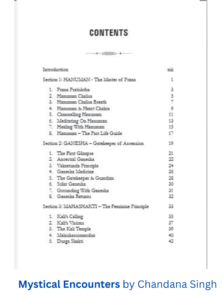
A reader finds your book attractive. Congratulations, you have passed the first test of creating a title and a book cover that speaks to the reader. The reader is not quite sure whether the contents of the book are what he needs. He flips the pages of the book to arrive at the table of contents. He finds, to his dismay, a table of contents page with only the chapter numbers and pages, no name of chapter or any subheadings. He is pressed for time and goes on to the next interesting book. He flips to the content page, where he finds a well-laid-out table of contents design, with chapter names, subheadings and page numbers. His first thought is that the book also must be structured well. He can quickly gauge from the contents page whether the topics he is looking for are included or not. While the first book missed the chance to be bought, the second book immensely increased its chances by paying attention to an important detail that is often overlooked.
A well-structured table of contents design is more than a navigation tool—it sets the tone for your book, giving readers a glimpse of what to expect, enhancing the overall reading experience. Whether you’re a first-time Indian writer or a seasoned author, understanding how to create an engaging table of contents for a book is crucial.
1. What is the Ideal Structure for a Book’s Table of Contents?
An ideal structure for a book’s table of contents depends on the genre and purpose of the book. A non-fiction book, like a book on business or a self-help book, will benefit from a detailed TOC(Table of Contents) that includes chapter titles and subheadings. A fiction novel can have a simpler TOC with just the chapter numbers.
Here’s a Table of Contents example from Indian literature:
– In Namrata Agarwal’s Self-help book, The Secret is You, the TOC lists each chapter with short descriptions, helping readers quickly jump to practical advice. See image below.
– In Aditi Gangwar’s book Through the Mind’s Eye, a book poetry and short stories the TOC is minimal—just numbered chapters—keeping the mystery alive for readers.
When Formatting a Table of Contents for a book, ask yourself:
- ✔️ Does it align with my book’s genre?
- ✔️ Does it serve the reader’s needs?
- ✔️ Will it make my book more straightforward to navigate?
2. How Detailed Should the Table of Contents Be—Should Every Subheading Be Included?
A table of contents is largely a navigation tool, so it must provide easy scanning, chapter names, and numbers. Further details will depend on the book’s genre.
For example, if you’re creating a cookbook’s Table of Contents, including subheadings for different sections (e.g., appetisers, main course, desserts) helps readers locate recipes quickly.
But if you’re Creating a Table of Contents for a memoir, keeping the TOC concise with only chapter titles enhances readability.
📌 Golden Rule: More detail is helpful for practical or instructional books, but minimal for novels and creative works.
Pro tip: Use a Table of Contents Generator if you need an automatic Formatting a Table of Contents while writing your book.
3. What Are Some Formatting Best Practices for a Visually Appealing Table of Contents?
- Formatting a Table of Contents for a book isn’t just about content—it’s about presentation. Here’s how to make it visually engaging:
- 📌 Use Consistent Formatting: Keep font size, style, and alignment uniform.
- 📌 Include Page Numbers: Helps readers navigate your book effortlessly.
- 📌 Make it Skimmable: Avoid clutter by limiting long chapter titles.
- 📌 Use Spacing Wisely: Ensure enough space between sections for clarity.
For inspiration, check out the Table of Contents for a book example used by Indian publishers like Penguin India and Zorba Books. They often follow clean, minimal layouts.
4. How Can I Ensure My Table of Contents Reflects My Book’s Overall Theme and Flow?
Your TOC should resonate with your book’s central theme. For example, if you’re writing a spiritual book, make sure the TOC flows naturally, from fundamental concepts to deeper insights.
Table of Contents Examples:
📝 Before finalising your TOC, ask beta readers for feedback: Does the flow make sense? Is it intuitive? Beta readers can provide valuable insights into the readability and logical flow of your TOC. Adjust if needed.

– In Mystical Encounters by Chandana Singh, the TOC reflects the order of teachings, making it logical for readers.
Here’s a simple Table of Contents Example for an Indian non-fiction book:
| Chapter No. | Chapter Title | Page No. |
|---|---|---|
| 1 | Introduction: The Writer’s Journey | 1 |
| 2 | Researching and Structuring Your Book | 10 |
| 3 | Creating a Strong Outline | 22 |
| 4 | Table of Contents Design That Works | 35 |
| 5 | Formatting a Table of Contents | 47 |
| 6 | Publishing and Marketing Your Book | 60 |
Final Thoughts – Crafting a Table of Contents Design That Strengthens Your Book
While crafting TOC, one must keep eye appeal and ease of navigation in mind. The amount of detail provided will vary according to the book’s genre. Minimum to no details for a fiction novel, chapter names and a few subheadings for a self-help book, and much more detail for an academic book.
A thoughtfully created TOC enhances readability, attracts readers, and maintains a logical flow. Experiment with formats, refine your structure, and ensure it complements your writing style.
💡 Ready to finalise your book’s TOC? Use professional formatting tools or templates and share your experiences with fellow writers!
Would you like help creating a personalised TOC for your book?
Helpful Reading
Numbering the pages of your book
DIY vs. Professional Book Formatting: What’s Best?
Discover more from ZorbaBooks
Subscribe to get the latest posts sent to your email.

